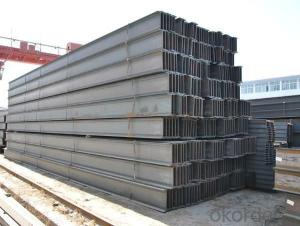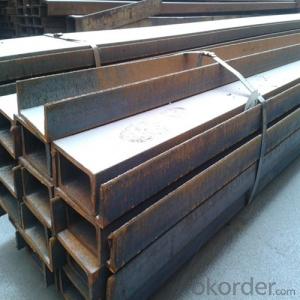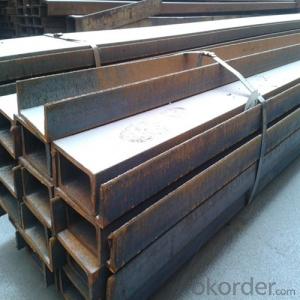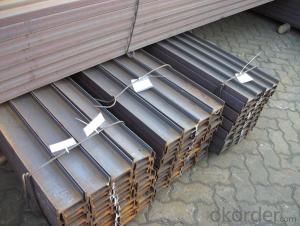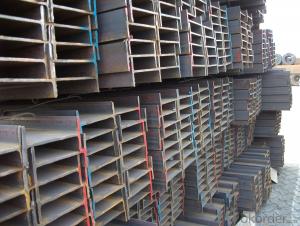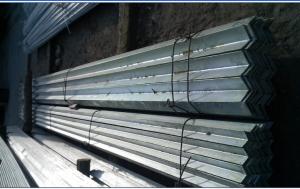IPE/IPEAA beams for sale
- Loading Port:
- Shanghai
- Payment Terms:
- TT OR LC
- Min Order Qty:
- 25 m.t.
- Supply Capability:
- 10000 m.t./month
OKorder Service Pledge
OKorder Financial Service
You Might Also Like
Specifications of IPE/IPEAA Beam Steel
1. Product name: IPE/IPEAA Beam Steel
2. Standard: EN10025, GB Standard, ASTM, JIS etc.
3. Grade: Q235B, A36, S235JR, Q345, SS400 or other equivalent.
4. Length: 5.8M, 6M, 9M, 10M, 12M or as your requirements

Section | Standard Sectional Dimensions(mm) | ||||
h | b | s | t | Mass Kg/m | |
IPE80 | 80 | 46 | 3.80 | 5.20 | 6.00 |
IPE100 | 100 | 55 | 4.10 | 5.70 | 8.10 |
IPE120 | 120 | 64 | 4.80 | 6.30 | 10.40 |
IPE140 | 140 | 73 | 4.70 | 6.90 | 12.90 |
IPE160 | 160 | 82 | 5.00 | 7.40 | 15.80 |
IPE180 | 180 | 91 | 5.30 | 8.00 | 18.80 |
IPE200 | 200 | 100 | 5.60 | 8.50 | 22.40 |
IPE220 | 220 | 110 | 5.90 | 9.20 | 26.20 |
IPE240 | 240 | 120 | 6.20 | 9.80 | 30.70 |
IPE270 | 270 | 135 | 6.60 | 10.20 | 36.10 |
IPEAA80 | 80 | 46 | 3.20 | 4.20 | 4.95 |
IPEAA100 | 100 | 55 | 3.60 | 4.50 | 6.72 |
IPEAA120 | 120 | 64 | 3.80 | 4.80 | 8.36 |
IPEAA140 | 140 | 73 | 3.80 | 5.20 | 10.05 |
IPEAA160 | 160 | 82 | 4.00 | 5.60 | 12.31 |
IPEAA180 | 180 | 91 | 4.30 | 6.50 | 15.40 |
IPEAA200 | 200 | 100 | 4.50 | 6.70 | 17.95 |
Applications of IPE/IPEAA Beam Steel
IPE/IPEAA Beam Steel are widely used in various construction structures, bridges, autos, brackets, mechanisms and so on.
Packing & Delivery Terms of IPE/IPEAA Beam Steel
1. Package: All the IPE/IPEAA Beam Steel will be tired by wire rod in bundles
2. Bundle weight: not more than 3.5MT for bulk vessel; less than 3 MT for container load
3. Marks:
Color marking: There will be color marking on both end of the bundle for the cargo delivered by bulk vessel. That makes it easily to distinguish at the destination port.
Tag mark: there will be tag mark tied up on the bundles. The information usually including supplier logo and name, product name, made in China, shipping marks and other information request by the customer.
If loading by container the marking is not needed, but we will prepare it as customer request.
- Q: What are the factors that affect the strength of steel I-beams?
- The strength of steel I-beams can be influenced by several factors. 1. The quality of the steel material used in manufacturing the I-beams is crucial in determining their strength. I-beams made from steel with higher yield and tensile strengths tend to be stronger. 2. The cross-sectional shape of the I-beam can impact its strength. The depth and thickness of the flanges and web, as well as the overall geometry, contribute to the beam's ability to resist bending and torsional forces. 3. The way in which the load is distributed across the beam can affect its strength. Uneven loading or concentrated loads in specific areas can result in localized stress and potential failure. 4. The length of the span or the distance between supports can influence the strength of the I-beams. Longer spans can induce higher bending moments, necessitating stronger beams to withstand the applied loads. 5. Temperature variations can affect the strength of steel I-beams due to thermal expansion and contraction. Extreme temperature changes can cause the beams to expand or contract, potentially compromising their structural integrity. 6. The quality of the welds used to join different sections of I-beams can impact their overall strength. Properly executed, high-quality welds contribute to the structural integrity of the beams. 7. Exposure to corrosive substances or harsh environmental conditions, such as moisture, chemicals, and saltwater, can degrade the strength of the steel over time. Regular maintenance and the application of protective coatings can help mitigate these effects. Considering these factors is essential when designing and selecting steel I-beams for various applications to ensure the desired strength and structural integrity.
- Q: What are the typical deflection limits for steel I-beams?
- The typical deflection limits for steel I-beams vary depending on the specific application and design requirements. However, there are some general guidelines and standards that are commonly followed in structural engineering. In most cases, the deflection limits for steel I-beams are based on the span length of the beam and the type of load it is expected to carry. The deflection limit is often expressed as a ratio of the beam's deflection to its span length. For beams supporting live loads, such as floor beams or roof beams, the deflection limit typically ranges from L/360 to L/240, where L represents the span length of the beam. This means that the maximum deflection of the beam should not exceed 1/360th to 1/240th of its span length. For beams supporting dead loads, such as beams in a building's structure, the deflection limit is often more stringent. In these cases, the deflection limit can be as low as L/480, ensuring minimal sagging or bending of the beam under the weight of the structure. It is important to note that these deflection limits are general guidelines and can vary depending on the specific design requirements, load conditions, and building codes in different regions. Structural engineers and designers are responsible for determining the appropriate deflection limits based on the specific project and its unique requirements. Overall, the deflection limits for steel I-beams are established to ensure the structural integrity and functionality of the beams while maintaining a safe and stable design.
- Q: Span seven meters of suspended beam, can I put a beam inside the beam with pouring, increase the intensity?
- Of course, it can be done. This is steel concrete structure, better than reinforced concrete.
- Q: Can steel I-beams be used in corrosive environments?
- With proper precautions and coatings, steel I-beams can be utilized in corrosive environments. Due to its strength and durability, steel is widely employed in construction. It can endure corrosive surroundings if adequately safeguarded. To prevent or minimize corrosion, steel I-beams can be treated with galvanizing, epoxy coatings, or corrosion-resistant paint. These coatings serve as a barrier between the steel and the corrosive environment, avoiding direct contact with moisture, chemicals, or other corrosive agents. Regular maintenance and inspections are crucial to promptly identify signs of corrosion and take necessary measures to address them. By implementing suitable protective measures, steel I-beams can be effectively employed in corrosive environments while preserving their structural integrity and longevity.
- Q: What are the considerations for waterproofing when using steel I-beams?
- When considering waterproofing for steel I-beams, there are several important factors to take into account. Firstly, it is crucial to ensure that the steel beams are properly coated or treated to prevent corrosion. Steel is prone to rust and degradation when exposed to moisture, so a high-quality protective coating or treatment should be applied to the surface of the beams. This will help to maintain their structural integrity and prevent water from seeping into the material. Another consideration is the connection points between the steel beams and other structural elements, such as walls or floors. These connection points need to be carefully sealed to prevent any water infiltration. The use of waterproof sealants or gaskets at these junctions can help create a watertight barrier and prevent any potential leaks. Additionally, the design and construction of the building should incorporate proper drainage systems to divert water away from the steel beams. This can include the installation of gutters, downspouts, and adequate slope in the surrounding landscape to ensure proper water runoff. By effectively managing water flow, the risk of water pooling or accumulating around the steel beams is minimized. Furthermore, it is important to consider the potential for condensation to occur on the steel beams. When warm air comes into contact with cold surfaces, condensation can form, leading to moisture build-up. To prevent this, proper insulation should be installed to maintain a consistent temperature and minimize temperature differentials that could cause condensation. Adequate ventilation should also be provided to allow any trapped moisture to escape. Lastly, regular inspection and maintenance are essential to ensure the long-term waterproofing of steel I-beams. Periodic checks should be performed to identify any signs of water damage, corrosion, or leaks. Prompt repairs should be carried out if any issues are detected, such as reapplying coatings, resealing connection points, or addressing drainage problems. In conclusion, when waterproofing steel I-beams, it is crucial to address the potential for corrosion, seal connection points, manage water drainage, prevent condensation, and perform regular maintenance. By taking these considerations into account, the structural integrity of the steel beams can be preserved, ensuring the long-lasting durability of the overall construction.
- Q: What are the different fabrication methods for steel I-beams?
- Steel I-beams can be fabricated using various methods, each with its own benefits and applications. 1. The most commonly employed technique is hot rolling. This involves heating a sizable steel billet above its recrystallization temperature and then passing it through a series of rollers to shape it into the desired I-beam profile. Hot rolling ensures excellent structural integrity and consistent dimensions and mechanical properties. 2. Another method involves welding or assembling individual steel plates or sections to create the I-beam shape. This approach is often used for specialized or custom applications where the dimensions or properties of the I-beam need to be tailored. Welding can be accomplished using various techniques, such as submerged arc welding or gas metal arc welding, depending on the specific requirements. 3. Cold rolling is another technique utilized to shape steel strips or plates into the I-beam profile. Unlike hot rolling, this process is carried out at room temperature. Cold rolling is typically employed for smaller-sized I-beams or applications where precise dimensions and surface finish are crucial. It is also commonly used for stainless steel I-beams. 4. Extrusion is a process that can create intricate cross-sectional shapes with a continuous length. For steel I-beams, a heated billet is forced through a die to form the desired I-beam shape. Extrusion is frequently utilized to manufacture lightweight or specialized I-beams with unique profiles. Each fabrication method has distinct advantages and considerations, such as cost, production speed, size limitations, and the ability to meet specific design requirements. The choice of fabrication method depends on factors such as the desired I-beam size, properties, and application.
- Q: How do steel I-beams perform in terms of thermal bridging?
- Steel I-beams are known to have high thermal conductivity, which means they can conduct heat more easily compared to other building materials. This characteristic makes them prone to thermal bridging, which is the transfer of heat across a building envelope or thermal barrier. When steel I-beams are used in construction, they can create a thermal bridge in the building envelope. This means that heat can be easily transferred from the inside to the outside or vice versa through the steel beams. Thermal bridging can result in energy loss and reduced energy efficiency in a building. To mitigate thermal bridging in steel I-beams, insulation materials can be added around the beams to minimize heat transfer. Insulation can help reduce the impact of thermal bridging and improve the overall thermal performance of the building. Additionally, thermal breaks can be installed between the steel beams and the surrounding building elements to further reduce the heat transfer. In summary, steel I-beams have a high potential for thermal bridging due to their high thermal conductivity. However, with proper insulation and the use of thermal breaks, the negative effects of thermal bridging can be minimized, resulting in improved energy efficiency and thermal performance of the building.
- Q: Can steel I-beams be used for theater stage supports?
- Yes, steel I-beams can be used for theater stage supports. They are commonly used in the construction of theater stages due to their strength, durability, and ability to support heavy loads.
- Q: What is the weight-bearing capacity of steel I-beams?
- The weight-bearing capacity of steel I-beams can vary depending on various factors such as the size and dimensions of the beam, the type of steel used, and the specific load distribution. However, steel I-beams are known for their high strength and load-bearing capabilities, making them capable of supporting heavy loads ranging from a few hundred pounds to several tons. Engineering calculations and structural analysis are typically performed to determine the precise weight-bearing capacity of a steel I-beam in a specific application.
- Q: Are steel I-beams suitable for elevated water tanks?
- Yes, steel I-beams are suitable for elevated water tanks. Steel I-beams are known for their strength and durability, making them ideal for supporting the weight of water tanks placed at elevated heights. Additionally, steel I-beams offer excellent load-bearing capabilities, ensuring the stability and structural integrity of the elevated water tank.
Send your message to us
IPE/IPEAA beams for sale
- Loading Port:
- Shanghai
- Payment Terms:
- TT OR LC
- Min Order Qty:
- 25 m.t.
- Supply Capability:
- 10000 m.t./month
OKorder Service Pledge
OKorder Financial Service
Similar products
Hot products
Hot Searches
Related keywords
